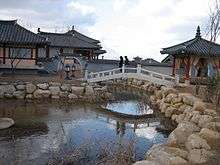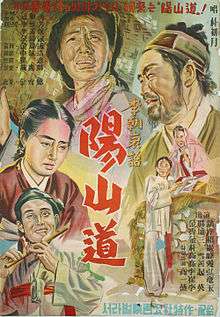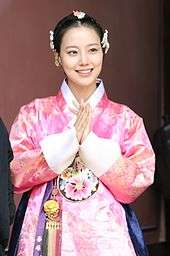Sageuk
| Sageuk | |
 Yongin MBC Daejanggeum Park, where many sageuk television series are shot | |
| Hangul | 사극 |
|---|---|
| Hanja | 史劇 |
| Revised Romanization | sageuk |
| McCune–Reischauer | sagŭk |
Sageuk (Hangul: 사극; Hanja: 史劇; ![]() listen ) in Korean denotes historical period dramas, including traditional drama plays, films or television series.[1][2] In English language literature sageuk usually refers to historical films and television series (of South Korea).[3][2][4]
listen ) in Korean denotes historical period dramas, including traditional drama plays, films or television series.[1][2] In English language literature sageuk usually refers to historical films and television series (of South Korea).[3][2][4]
The first known historical film, The Story of Chun-hyang was made in 1923, directed by a Japanese filmmaker. The first Korean sound film was also sageuk. The heyday of Korean cinema began in the 1950s and lasted until the 1980s, with many sageuk films released, like Lee Gyu-hwan's Chunhyang adaptation in 1955. In the 1960s, historical melodramas were significant, as well as martial arts films. In the 1970s, due to the popularity of television, cinema started to decline, and in the 1980s it encountered a crisis, which prompted filmmakers to try to win viewers back with erotic pieces. From the 1990s, Im Gwon-taek's movies, as well as The Legend of Gingko and The Eternal Empire are significant works. From the 2000s, sageuk films started flourishing, between 2012 and 2015 Korean cinema produced five sageuk that broke the 10 million viewership record. As of 2016 June, the highest grossing South Korean film is also a historical drama: The Admiral: Roaring Currents.
The first television series, a sageuk, of South Korea aired on state channel KBS in 1962, titled Gukto malli. In the 1970s, in contrast to the previous decade, historical TV series portrayed national heroes like Yi Sun-shin or Sejong the Great. The characteristic series of the 1980s was Joseonwangjo 500 nyeon ("500 Years of Joseon"). The 1990s were dominated by contemporary dramas with regards to popularity and viewership ratings, despite having produced a number of quality sageuk. The 2000s saw the birth of the "fusion sageuk" genre, which changed the historical series genre in South Korea. Some of the significant works from this period are Hur Jun, Damo and Dae Jang Geum.
Popular themes of sageuk include elements from Korean folklore and mythology, famous or notorious princes, kings, national heroes and famous women.
History

Beginnings
The first film which can be regarded a sageuk was The Story of Chun-hyang, directed by Japanese filmmaker Koshu Hayakawa (早川孤舟) in 1923.[3][5] The story of Chunhyang is a popular element of Korean folklore, recurring in Korean cinema, as well, having produced more than a dozen adaptations both in films and television series. Some cinematic milestones are also related to it, for example Lee Myeong-woo's Chunhyangcheon (춘향전) in 1935 was the first Korean sound film.[3][2][6] From 1940, the number of Korean films declined, due to the Japanese colonialist policies forbidding films other than propaganda movies. Many filmmakers fled the country, those remanining had to join the pro-Japanese camp. After the second world war ended, filmmakers rather celebrated independence and did not make historical pieces.[7][8]
After the Korean war, romanticism was the ruling school of 1950s historical movies in South Korea, often focusing on female characters. The roots of this can be traced back to theatres: grand changgeuks, or folk operas, had been popular, so much so, that they began to be adapted to film. Since these stories focused on human nature, human fate and feelings, actual historical backgrounds were irrelevant. These stories usually preferred the period of the Three Kingdoms of Korea, factual details of which were scarce, thus attention to historical factual accuracy could be avoided. In 1956, Wangja Hodonggwa Nangnang gongju (왕자호동과 낙랑공주) adapted the story of Prince Hodong and the Princess of Nakrang, Korea's very own Romeo and Juliet tale.[2][9]
The period from the 1950s to the 1980s are considered the heyday of Chungmuro, or the Korean Hollywood, when more than 100 films were produced annually. The need for historical films was boosted by the success of such works as Lee Gyu-hwan's Chunhyang adaption (1955), Kim Ki-young's Yangsan Province or Jeon Chang-geun's Gojong hwangjewa uisa An Jung-geun (King Gojong and martyr An Jung-Geun; 1959).[10]
1960s
Sageuk successes of the 1960s were adaptations of works that had previously been successful in other art forms, for example as radio plays, theatrical plays, changgeuk operas or novels. Examples include Jang huibin (장희빈; 1961), Naesi (내시, "Eunuch"; 1968) or Women of Yi Dynasty (이조 여인잔혹사, Ijo yeoinjanhoksa; 1969). The atmospehere this time was more conservative than in the '50s, partially due to Park Chung-hee's dictatorship. Conforming to the circumstances, historical melodramas were preferred, but there were exceptions like Jeong Chang-hwa's martial arts films, inspired by the Shaw Brothers.[2] This is the period when Joseon became the focus of attention, depicting the relationship between kings and officials, determining the nature of historical films for the next decades. Viewers were now more interested in actual historical events than in mystified, old legends. Previously, people were searching for familiar themes in sageuk, due to modern inventions being relatively new to Korea at the time. By the 1960s, however, they got used to modernities, thus filmmakers turned to decadent themes or novel stories.[9][11][6]
_02.jpg)
The first historical television series in South Korea was aired in 1962 on state channel KBS, titled Gukto malli (국토만리), directed by Kim Jae-hyeong (김재형), set in the era of Goguryeo.[3][12]
1970s
As television sets started to be rolled out en masse, the number of television series also grew. Just like in cinema, however, the policies of the ruling regime affected them as well. Thus dramatic historical figures were replaced by national heroes like general Yi Sun-shin or Sejong the Great.[2] Sageuk of the time mixed legends and reality, the major cause of which was the enormous demand for TV series. Historical factual accuracy would have required scriptwriters to research historical documents written in hanja characters, which, considering the demand and the daily episodes, would have been impossible. Also, legends were easier to be dramatized.[3]
As television dominated, cinema declined,[9] and out of all the historic films of the period only two could achieve success at the box office: Lee Gyu-ung's Seongung Yi Sun-shin (성웅 이순신) and yet another Chunhyangga adaptation, this time by Lee Seong-gu.[2] Critics applauded other works, like Gate of Woman (홍살문, Hongsalmun, 1972), An Executioner (망나니, Mangnani, 1974), Concentration of Attention (집념, Jibnyeom, 1976) or A War Diary (난중일기, Nanjungilgi, 1977).[13]
1980s
The characteristic classic sageuk TV series of the 1980s was Joseonwangjo 500 nyeon (조선왕조500년, "500 Years of Joseon"), which ran for 8 years, airing 11 separate TV series with over 800 episodes altogether, depicting the history of Joseon. The series referenced official historical documents (albeit liberally to some extent) and often included debated events and themes. It was directed by Lee Byung-hoon, who later also helmed the popular hallyu series Dae Jang Geum.[3][2][14] The state channel KBS aired Gaeguk (개국, "Founding of the Nation") which depicted King Taejo's usurpation of the Goryeo throne in an overtly positive light, reminiscent of Jeon Du-hwan's rise in politics.[2]
The diverse programming on television devoured viewers from attending cinemas, and the film industry had but one way out: show a genre that could not be accessed through television. This is why they turned to making erotic films, a good portion of which were set in historical times. Movies like Eoudong (1985) or Does the Cuckoo Cry at Night (뻐꾸기도 밤에 우는가, Bbakkugido bame unenga, 1985) were also popular at the box office. Although erotic movies were popular, the sageuk genre saw a decline in South Korean cinema generally.[3][2]
1990s

At the beginning of the 1990s, historical films were scarce, except for Bae Chang-ho's Kkum (꿈, Dream; 1990). The Eternal Empire (영원한 제국), which received outstanding crtics, was released in 1995. The film is significant for its different take on the popular story of Crown Prince Sado, focusing on the political aftermath of his death, rather than the pain of the prince himself. Although it did not do well at the box office, the film received eight awards at the Grand Bell Awards, including Best Film and Best Director.[2] Im Gwon-taek's period films are also notweworthy, as well as The Legend of Gingko from 1996.[9]
The 1990s saw a number of good quality sageuk on television, like Han Myeong-hui (한명회, 1994), Jang Nok-su (장녹수, 1995), Tears of the Dragon (용의 눈물, 1996–1998) or King of the Wind (대왕의 길, 1998). However, viewership ratings could not match up to that of contemporary Korean dramas, only a few could reach 30%, while for example the modern themed Sandglass broke 50.8%.[15][3]
2000s
At the beginning of the 2000s, sageuk were preferred by older generations. Young people chose to watch contemporary series, which they could better relate to. Sageuk were often complicated, archaic in language use, and mainly employed older actors — thus were less appealing to younger generations. A change in attitude is attributed to producer and director Lee Byung-hoon, who entrusted the script of Hur Jun to a young, up-and-coming scripwriter, Choi Wan-gyu. Instead of dry historical facts and distant wars, the series focused on emotions and relationships, revolving around the legendary Joseon royal physician. A new genre, "fusion sageuk" was born, changing the structure and format of Korean historical television series. In 2003, actress Ha Ji-won starred in Damo, the first HDTV format Korean TV series. The drama merged characteristics of trendy modern dramas with Hong Kong style wire-fu action scenes, narrating a fictional story set in a real historical time.[3]

As fusion sageuk conquered televisions, they started to infiltrate cinema, as well. This can be attributed partially to the success of television dramas and partially to the international success of such Chinese historical epics like Crouching Tiger, Hidden Dragon, Hero or the American Gladiator, prompting the need to produce such works at home, as well.[9] In 2003, Untold Scandal with drama icon Bae Yong-joon was released but the real turning point in historical films came in 2005 with The King and the Clown, breaking box office records selling more than 12 million tickets.[16][3] Period films are also successful in the 2010s in South Korea, between 2012 and 2015, five out of all the films surpassing 10 million viewers were sageuk, and the record keeper (as of 2016 June) is also a historical piece: The Admiral: Roaring Currents sold 17.61 million tickets. The most popular ones are also of the fusion type, mixing historical facts with ficitonal people or events. Such works include for example, The Face Reader or Masquerade. Apart from so-called palace dramas, spectacular action-filled sageuk like War of the Arrows, The Grand Heist or Pirates are also successful in the 21st century. Film series have also appeared, like the Detective K-series, placing a crime investigation story into Joseon settings. Erotic period films experience a renaissance in South Korean cinema, with pieces like Forbidden Quest, The Servant or Empire of Lust.[17][9]
Sungkyunkwan Scandal (2010), Moon Embracing the Sun (2012) and Love in the Moonlight (2016) are all sageuk adapted from popular novels. They were initially targeted to younger demographic but has since received mainstream and international success.[18] The productions have also put the spotlight to then emerging actors Song Joong-ki, Yoo Ah-in, Kim Soo-hyun, Park Bo-gum and Kim Yoo-jung.[19]
Popular themes
Popular themes include the following:[2][20][3]
- Elements of Korean folklore: pansori tales like Chunhyangga; folk tales like Prince Hodong and Princess Nakrang; mythological creatures like gumihos
- Three Kingdoms of Korea
- Joseon princes and kings, especially those with dramatic life stories like Crown Prince Sado, King Yonsangun, King Jeongjo, Sejong the Great, Emperor Gojong, King Taejo of Joseon
- Famous women: like Hwang Jin-yi, Hui-bin Jang, Jang Nok-su, Queen Munjeong
- Famous soldiers: like Yi Sun-shin
- Cross-dressing heroines
Notes
- 1 2 3 4 5 6 7 8 9 10 11 12 TwitchFilm.
- 1 2 3 4 5 6 7 8 9 10 11 YumCha.
- ↑ Alison Peirse (2010). Korean Horror Cinema. Edinburgh University Press. p. 84. ISBN 9780748643103.
- ↑ Korean Cinema 1 Chapter: The Exhibition of Moving Pictures and the Advent of Korean Cinema 1897~1925, p. 19.
- 1 2 Pacquet.
- ↑ Korean Cinema 2 Chapter: The Sound Film and Militarism 1935~1945; pp. 73–77.
- ↑ Korean Cinema 3 Chapter: Liberation and the Korean War 1945~1953
- 1 2 3 4 5 6 Lee.
- ↑ Korean Cinema 4 Chapter: The Revival the Film Industry 1954~1962; pp. 133–134.
- ↑ Korean Cinema 5 Chapter: The Korean Cinema Renaissance and Genre Films 1963~1971; pp. 172–174.
- ↑ "국토만리(國土萬里)" (in Korean). National Institiute of Korean History. Retrieved 2014-06-02.
- ↑ Korean Cinema 6 Chapter: The Authoritarian Period and a Depression in the Film Industry 1972~1979; p. 227.
- ↑ KOCIS, p. 63.
- ↑ KOCIS, p. 65–66.
- ↑ D’Sa, Nigel (25 April 2006). "King and the Clown Retires After Hit Run". Korea Film Biz Zone. Korean Film Council. Retrieved 2016-01-07.
- ↑ KoBiz 1.
- ↑ "[기획] '구르미 그린 달빛'이 이어갈까…퓨전사극 속 꿀케미 커플+명대사 톱5". Naver.
- ↑ "[SW분석] 박보검, 김수현과 꼭 닮은 성장방식 url=http://m.entertain.naver.com/read?oid=396&aid=0000407016". Naver.
- ↑ Kobiz 1.
References
- "How Period Films Became the Hottest Trend in Korean Cinema in the 21st Century?". Korean Film Biz Zone. Korean Film Council. 2015-09-07. Retrieved 2016-01-11.
- K-Drama: A New TV Genre with Global Appeal (pdf). KOCIS. 2011. ISBN 978-89-7375-167-9. Retrieved 2016-01-13.
- "Korea's fusion sageuk". Korea.net. 2012-03-12. Retrieved 2016-01-11.
- Kim Mi-hyeon, ed. (2007). Korean cinema: from origins to renaissance (pdf). CommBooks/KOBIZ.
- Darcy Pacquet. "A Short History of Korean Film". Koreanfilm.org. Retrieved 2016-01-11.
- Lee Yong-cheol (2014-01-24). "The Secret of Period Drama". KOFIC. Retrieved 2016-01-13.
- "사극" (in Korean). Naver Dictionary. Retrieved 2016-01-11.
- "영원한 제국 (Eternal Empire) and Chungmuro's Love-Hate for History". TwitchFilm. 2009. Retrieved 2016-01-11.
- "Sageuk, Korea's 80 Year Long Love for History". YumCha/Yesasia. 2007-05-14. Retrieved 2016-01-11.

